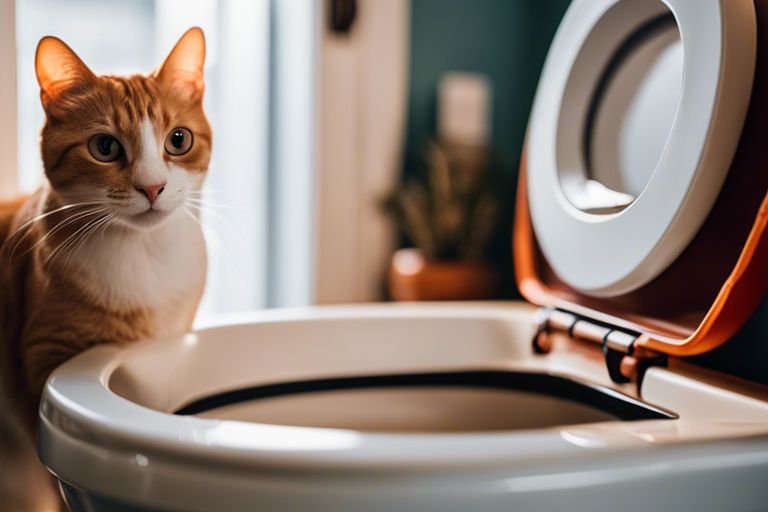The Ultimate Guide To Kitty Toilet Training – Tips And Tricks

Overwhelmed by scooping litter boxes all the time? Look no further! Training your cat to use the toilet can be a game-changer in your household. In this ultimate guide, we will provide you with step-by-step tips and tricks to successfully toilet train your feline friend. From choosing the right training tool to troubleshooting common issues, we’ve got you covered. Say goodbye to litter mess and hello to a cleaner and more convenient solution for your cat’s bathroom needs.
Key Takeaways:
- Gradual Transition: Start with a litter box next to the toilet and gradually raise the litter box level until it matches the toilet height.
- Positive Reinforcement: Use treats and praise to reward your kitty’s progress during each step of the Kitty toilet training process.
- Patience is Key: Kitty Toilet training takes time, so be patient and don’t rush your cat through the process.
- Consistency is Important: Stick to a routine and schedule for toilet training to help your cat understand what is expected of them.
- Encourage Natural Instincts: Cats are naturally clean animals, leverage this instinct to teach them how to use the toilet.

Types of Kitty Toilet Training Methods
Little do many cat owners know, there are multiple methods available when it comes to kitty toilet training. Each method comes with its own set of benefits and challenges, so it’s important to find the one that works best for you and your feline friend.
| Litter Box Training | Teaching your cat to use a litter box |
| Toilet Training Seats | Gradually transitioning your cat from litter box to toilet |
| Transitioning Methods | Methods to seamlessly shift from toilet to toilet training seats |
| Behavior Modification | Training your cat through positive reinforcement techniques |
| Professional Training Services | Seeking help from experts in cat behavior and training |
Litter Box Training
Now, if you have a new kitten or a cat that is not yet toilet trained, starting with a litter box is the first step in toilet training. Place the litter box in a quiet and accessible location, and ensure it is kept clean to encourage your kitty to use it consistently. Remember to reward your cat with treats and praises when they use the litter box to reinforce this positive behavior.
Kitty Toilet Training Seats
The key to successful kitty toilet training seats is patience and consistency. Start by placing the kitty toilet training seat next to the litter box to help your cat get used to the new setup. Gradually raise the height of the seat and move it closer to the toilet bowl over time. Once your cat is comfortable using the seat, it’s time to make the final transition to the toilet. Be mindful of, each cat learns at its own pace, so be patient throughout the process.
Kitty Toilet training seats are designed to fit most standard toilets and come with training guides to help ease the transition for your cat. They typically have a gradual incline to mimic the litter box and a secure base to prevent accidents. Some seats also come with a training insert that can be filled with litter to make the transition even smoother. Remember to provide positive reinforcement and rewards for successful toilet usage to encourage your cat’s progress.

Transitioning Methods
Clearly, transitioning methods are crucial for helping your cat move from using a Kitty toilet training seat to using the actual toilet. This phase requires patience and consistency as your cat adapts to the new surface and environment. Gradually remove the kitty toilet training seat and monitor your cat’s progress to ensure they are comfortable with the change. Be mindful of, positive reinforcement is key to successfully transitioning your cat to using the toilet independently.
Understanding your cat’s behavior and preferences is important during the transitioning phase. Some cats may take longer to adjust to the new routine, while others may catch on quickly. Provide a comfortable and stress-free environment for your cat during this transition period to help them feel at ease as they learn this new skill. With patience and positive reinforcement, your cat will soon be confidently using the toilet like a pro.
Factors to Consider Before Starting Kitty Toilet Training
Now, before you begin kitty toilet training, there are a few key factors you should consider to ensure a successful and smooth transition. Here are some crucial points to keep in mind:
- Your Cat’s Age and Health
- Time Commitment and Consistency
- Adaptability and Personality of Your Cat
Though each cat is unique, understanding these factors will help set realistic expectations and guide you through the training process effectively.
Your Cat’s Age and Health
Your cat’s age and health play a significant role in their ability to adapt to toilet training. Younger, healthier cats tend to pick up new habits more quickly, while older cats or those with health issues may require more time and patience.
Time Commitment and Consistency
One of the most critical factors in successful kitty toilet training is your time commitment and the consistency of your training methods. Cats thrive on routine, so being consistent in your approach and dedicating time to the training process is vital.
Training your cat to use the toilet requires patience, persistence, and a commitment to consistency. Start by creating a schedule for training sessions and stick to it daily. Consistency is key to helping your cat understand and adapt to the new behavior.
Adaptability and Personality of Your Cat
Some cats are naturally more adaptable and open to change, making them ideal candidates for toilet training. Others may be more set in their ways or easily stressed by changes in their environment.
For instance, if your cat is easily stressed or has a history of anxiety, you may need to take a slower approach to toilet training, gradually introducing new elements to avoid overwhelming them. Understanding your cat’s personality will help tailor your training methods to suit their individual needs.

Step-By-Step Guide to Kitty Toilet Training
Preparing for the Transition
| An | Plan |
| Set up a designated toilet area for your kitty with a training seat | Fill the area with litter to help your cat associate the spot with using the bathroom |
Tips for a Smooth Training Process
| Process | Tips |
| Start gradually by moving the litter box closer to the toilet over time | Be patient and consistent with the training process to avoid confusing your cat |
- Use positive reinforcement like treats or praise when your kitty successfully uses the toilet
- Assume that setbacks may occur, and it’s normal for progress to be slow
Troubleshooting Common Issues
| Training | Issues |
| Some | cats may resist the change from a litter box to a toilet |
Plus, providing multiple toilet options within your home can help alleviate your kitty’s stress during the training process.
Pros and Cons of Kitty Toilet Training
| Pros | Cons |
| Eliminates the need for a litter box | May be more challenging for older or stubborn cats |
| Helps keep the house cleaner and odor-free | Requires patience and consistency |
| Can save money on litter | Some cats may resist the change |
| Environmentally friendly | Accidents may happen, causing mess and stress |
Advantages of Having a Toilet-Trained Cat
You may find that having a cat that is toilet-trained can bring many benefits to both you and your pet. Not having to deal with a litter box can make your home cleaner and more pleasant, and it can also save you money on buying litter over time. Additionally, it is an environmentally friendly option as it eliminates the need for disposable litter.
Potential Drawbacks and Considerations
An important consideration when Kitty toilet training is the level of commitment and patience required. Some cats may not take to toilet training easily and accidents can happen during the training process. It’s crucial to be prepared for setbacks and to provide your cat with alternative options if they struggle with the transition.
The Ultimate Guide to Kitty Toilet Training is a comprehensive resource that can help guide you through the process and provide additional tips and tricks for successful toilet training. Visit The Ultimate Guide to Toilet Training Your Cat for more information.
To wrap up
From above guide, we have covered the imperative tips and tricks for successfully kitty toilet training. Remember to be patient, consistent, and use positive reinforcement throughout the training process. By following the guidance provided, you can gradually transition your cat from using a litter box to using a human toilet. With dedication and perseverance, you can achieve the ultimate goal of a toilet-trained kitty, leading to a stress-free and odor-free home environment. Follow these steps diligently, and you will soon be enjoying the convenience and cleanliness of having a toilet-trained cat in your household.
FAQ
Q: Why should I consider kitty toilet training?
A: Kitty Toilet training can eliminate the need for a litter box, reduce odors in your home, and provide a cleaner environment for both you and your cat.
Q: How do I know if my cat is a good candidate for toilet training?
A: Cats that are comfortable using a litter box, have good balance, and are receptive to training are typically good candidates for toilet training.
Q: What are some tips for successfully Kitty toilet training?
A: Start by gradually moving your cat’s litter box closer to the toilet, then transition to a training seat that fits over the toilet bowl. Use positive reinforcement and be patient throughout the training process.
Q: Are there any potential challenges I may face while Kitty toilet training?
A: Some cats may be resistant to the change or have difficulty with the balance required for using the toilet. It’s important to be observant of your cat’s behavior and progress, and be prepared to adjust your training methods if needed.
Q: How long does it typically take to toilet train a cat?
A: The length of time it takes to toilet train a cat can vary depending on the individual cat and their comfort level with the training process. Some cats may learn quickly within a few weeks, while others may take several months to fully transition to using the toilet.




